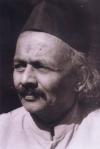Biography
Dattatreya Ramachandra Bendre (Kannada:?????????? ???????? ??????? ; Marathi: ?????????? ???????? ???????) was amongst the most famous of Kannada poets of the Navodaya Period. Praised as varakavi, literally 'gifted poet', he was the second person among eight recipients of Jnanpith Award for Kannada, the highest literary honour conferred in India. He wrote under the pen-name of Ambikatanayadatta ("Datta, Child of Ambika"). He also held the title Karnataka kula Thilaka ("The light of the Kannada Nation") conferred by Udupi Adamaru Math. He was conferred Padma Shri by Government of India.
Early Life and Education
He was born on into a Madhwa Brahmin family at Dharwad in Karnataka. His Grand father was a Dasagranthi (Master of ten volumes of sacred lore) and scholar in Sanskrit classical literature. Dattatreya's father was also a Sanskrit scholar who died when Dattatreya was only 12 years old. Dattatreya later adopted the pen-name of Ambikatanayadatta which literally means Datta, son of Ambika after his mother who ran a Khanavali or eatery to feed the family. Bendre completed his primary and high school education in Dharwad with his uncle's help and completed his matriculation in 1913. He joined the Fergusson College, Pune for his higher education. After obtaining his degree Bendre returned to Dharwad and started teaching at Victoria high school. He married Laxmibai from Ranebennur in 1919. He obtained his Master of Arts degree in 1935.
Career
Starting his career as a teacher at Victoria high school in Dharwad, he worked as a professor of Kannada in D.A.V. College Solapur between 1944 and 1956. In 1956 he was appointed an advisor for All India Radio's Dharwad station.
Later Life
Bendre formed the Geleyara Gumpu (Group of Friends) in 1922. Mainly intended as a peer group for the study of culture and literature, this friends' circle drew poets, writers and intellectuals from different parts of Karnataka including Ananda Kanda, Sham. Ba. Joshi, Siddavanahalli Krishna Sharma, Enke, G.B.Joshi, Krishnakumar Kallur, V. K. Gokak and R. S. Mugali. In 1926 Bendre started the cultural movement Nada-habba, a celebration of the land and its culture which is still prevalent in Karnataka. This festival is celebrated during the navaratri. In 1932 Bendre was sentenced to imprisonment for writing Nara Bali (Human Sacrifice), which was then branded seditious. He was under house arrest in Mugad village. Bendre's two sons Panduranga and Vamana and daughter Mangala were the only three surviving children among nine who were born. In 1943 he presided over the 27th Kannada Sahitya Sammelana held at Shimoga. He went on to become a fellow of the Kannada Sahitya Parishat. In 1972 the Government of Karnataka produced a documentary on his life.
Works and Message
Bendre started off with simple and earthly romantic poetry, often using the "spoken" language. His later works dig deeper into social and philosophical matters. G. S. Amur, a leading critic in Kannada, says "Bendre believed in the value of an integrated personality but loved to project himself as a threefold being: Dattatreya Ramachandra Bendre, the biological self, the dehi; Professor Bendre, the thinking self; and Ambikatanayadatta, the creative self. The three selves were conceived as mutually supporting selves, as the imagery Bendre used to concretise this idea clearly suggests. He spoke of Ambikatanayadatta and Professor Bendre as closely related to each other as the banks of a river or the belly and the back. One could not exist without the other."
Bendre has been hailed as the father figure of modern Kannada poetry. His poems are linked to the Kannada poetic tradition through their use of folklore, the vachanas and the kirthanas. Apart from native prosodic forms, Bendre has also employed native imagery, folk beliefs, references to Indian mythology and the language spoken by common people. Nada Lila (The Play of Sounds) is perhaps the most remarkable of his poetry collections.. All the features of Navodaya poetry like patriotism, the reformatory zeal, critical attitude, Indian culture, consolidation of traditional strength, mystical faith and assertion of a poet's individuality can be found in this collection of poems.
Bendre used diverse techniques for spiritual lyrics, classical style for sonnets and traditional as well as colloquial idiom for pastoral and folk lyrics. Symbolism is characteristic of his poetry. His poem Patargitti (Butterfly) sung as a nursery rhyme speaks of colors of temptation. Another one Mudalmaneya (Morning) becomes symbolic of all pervading peace or, the poet's yearning for it. In the Kuniyonu bara (Dance Eternal) all diverse currents of thought meet in on great confluence. Apparently, all Bendre's poems could be set to music and abound in alliteration; but there was always a hidden layer of meaning which only a trained poetic mind could decipher.
As a person, Bendre was friendly, suave and sociable. He mixed with intellectuals and illiterate villagers on equal terms. He loved and interpreted life in different colors.
Towards the end of his life Bendre was deeply absorbed in numbers. This was not a new interest for him but now it became a central concern. When Dom Moraes visited him during his exploration of Karnataka in 1976, he found him totally immersed in numbers. In his books Vishvadharanasutra and A Theory of Immortality Bendre made ambitious attempts to intuit all knowledge into numbers.
Awards and honors
Jnanpith Award - 1974 (For the collection of poems Naaku Tanti)
Padma Shri - 1968
Sahitya Academy award - 1958
Kelkar prize - 1965
Fellowship of Sahitya Academy - 1968
And many more. ..






